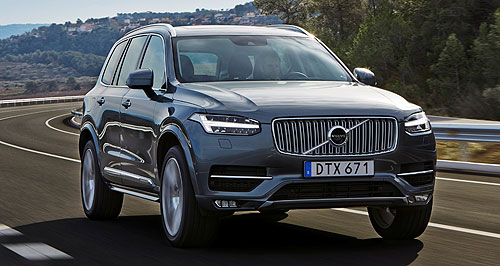Make / Model Search
News - VolvoVolvo boss expects a 2015 turnaroundFresh approach: New XC90 (below) and V60 Cross Country (left) for 2015 but much more coming in 2016 as Volvo shrugs off a dismal 2014. New product is 'fire starter' says new Volvo chief in his first media interview8 May 2015 By NEIL DOWLING NEW product, kicking off with the all-new XC90 SUV in August, will drive Volvo forward and extinguish a disappointing year of sliding sales in Australia. In his first media interview since taking over Volvo Car Australia’s top job in September last year, its managing director Kevin McCann told GoAuto he sees a “very exciting” period ahead with the XC90 and the V60 Cross Country freshening the range in 2015. For the future, he is banking on a continued product assault, led by the S90 large luxury sedan. Mr McCann said he is pushing for a 2016 launch for the new premium saloon but knows it could be delayed by production timing and customer demand in Europe. “It could be later but I would like it in 2016,” he said of the S90. “The gap between a new Volvo model launch in Europe and one in Australia is narrowing.” The S90 is one of four 90-badged vehicles, following the XC90 SUV but preceding the V90 wagon and the higher riding V90 Cross Country wagon. For now, Mr McCann said the XC90 is proving to be a winner in Australia, even before its showroom debut. “We have very strong interest and orders on this car,” he said. “This is a top-selling model for us and is very important to our line up.” The new seven-seat SUV was also Volvo’s foray into online buying. When Volvo announced the new XC90 back in August 2014, it offered 1927 First Edition versions to prospective buyers via its website. The 1927 production refers to the year of Volvo’s inception. “We sold out in 16 hours,” Mr McCann said. “There were 10 successful buyers in Australia. It was an example to us of how effective online is but it’s not something we’re considering as a sales tool in Australia.” The effect of the XC90 on Volvo’s Australian sales can be judged by the run-out of the old model. The sales slump that caught Volvo in the past 12 months was caused “at least two-thirds” by the dribble supply of the previous model, Mr McCann said. Volvo’s passenger cars slipped 9.3 per cent to 4693 units in calendar 2014 compared with the previous year. But in the four months to the end of April this year, Volvo fell 24.1 per cent to 1223 sales, while the overall market lifted 3.5 per cent. In the passenger-car segment that fell 4.4 per cent in the first four months of this year, Volvo’s car sales dropped 12.4 per cent. The SUV segment rose 15.7 per cent in the same period but Volvo recorded a 34 per cent slump. “The demise of the C70 (convertible) in the second half of 2014 also played a part in the sales figures,” Mr McCann said. “The models that left the market came at a time when the pace and competition within the Australian market and the high frequency of (rival) new model launches unbalanced our planning. “Now we have a different plan. We have to get a balance of supply and demand at a time with the XC90 when we’re experiencing a very strong order situation.” He said that he is “very optimistic” about the success of Volvo Car Australia in 2016. “We are comfortable with our range of cars,” he said. “The V40 (the smallest Volvo) is the ideal size for our market. It is also an example of our drivetrains and vehicle architecture that can be used from the small models up to the bigger cars without any compromise in performance. Mr McCann highlighted the Swedish car-maker's push into hybrid technology, which will ramp up with the XC90. “The XC90 T8 (a turbocharged and supercharged petrol engine with additional electric drive) is an outstanding package with tremendous performance yet has carbon-dioxide emissions below 50 grams per kilometre.” Mr McCann said the federal government could do more to promote low-emission cars but said it was difficult for one company to lobby for any form of subsidy to encourage their use. “It’s better if an organisation like the Federal Chamber of Automotive Industries takes this to the government,” he said. The FCAI is poised to do just that. This week it appointed Mr McCann to its board, along with the CEO of Mercedes-Benz Australia/Pacific, Horst von Sanden. Both represent companies with a growing range of hybrid and plug-in hybrid vehicles. “We’re hopeful that low-emission vehicles will be acceptable in Australia,” Mr McCann said. “But we need an agenda from the government. “For the buyer, there are two issues here. If there’s no incentive, there’s no reason for people to buy a low-emission vehicle. “Then there’s buyer anxiety. If they buy a low-emission vehicle today, they may miss out on a subsidy or rebate that comes into effect later.” Volvo owners have the highest demand for a plug-in hybrid car, according to the December 2014 Roy Morgan Research study. The study of more than 2.5 million Australians aged over 14 years found that 45.9 per cent seriously considered buying a hybrid. It showed that 64.2 per cent of Volvo potential owners thought about buying a hybrid. The Volvo XC90 will be the company’s first volume plug-in hybrid in Australia. It hoped to have the V60 plug-in hybrid – now on sale in Europe and Russia as a limited edition of 500 vehicles – in Australia this year. Volvo Car Australia is still awaiting Volvo’s production plans once the 500 vehicles have been sold.  Read more |
Click to shareVolvo articlesResearch Volvo Motor industry news |












Facebook Twitter Instagram